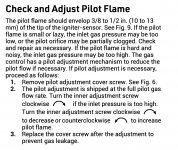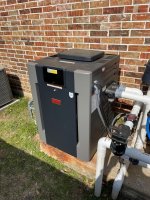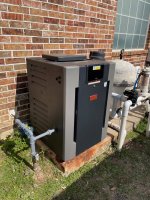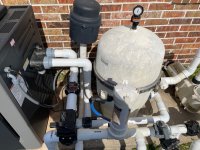Hey all, long time lurker but first time poster. I wanted to go over something that could really help someone out in the future since I beat my head against the wall for a few hours trying to solve this one. I just got done installing a new Raypak 336A heater and am very happy with it so far. The unit is well constructed and was reasonable to install. A major item I had an issue with that Raypak does not list in their manual is anything about pilot flame adjustment based on gas pressure. After I got the unit all hooked up and ready to fire, it tried to light itself for 90 seconds without avail and threw an error. I started testing everything - Gas input pressure, electrical, spark, etc. I figured I may just needed to adjust my gas pressure up or down according to what I had read in the Raypak manual. My gas is coming into the heater at 8" WC as measured with a manometer on the input side of the gas valve. From what I could tell, it seemed too high for the pilot to light at that pressure (could hear the gas flowing pretty good) even though the manual states "A minimum of 6 in. WC and a maximum of 10.5 in. WC upstream pressure under load and no-load conditions must be provided for natural gas." The Raypak manual does talk about adjusting gas pressure but as I later learned, that's ONLY for the main burner assembly.
Raypak Manual: "The pressure at the gas valve, taken with a manometer, should be about 4.0 in. WC natural gas and 10.5 in. WC propane gas. If an adjustment is needed, remove seal and turn adjustment screw clockwise to increase pressure or counter-clockwise to decrease pressure."
That's it. The only section in the whole manual that talks about gas pressure and how to adjust it... thanks Raypak. Stuck now with a brand new heater, a pilot that won't light, and a cold spa - I started digging in a bit. I pulled the manual for the Resideo (formerly known as Honeywell) gas valve and started reading. I discovered this section on page 8:

What Raypak doesn't tell you in their install guide is that the pilot flame pressure is not affected at all by the adjustment screw for pressure on the main burner, they're completely independent. However, the latter is the only one Raypak references. Once I turned down the pressure to the pilot light (I needed to turn mine 2-3 full turns clockwise) the pilot lit almost immediately and the heater came to life. Hopefully this is helpful to someone who stumbles on this in the future, I certainly wish I would have known this before having to fight with it for a few hours. I tossed a few pictures of my final install below for critique and linked the gas valve manual as well. I believe Raypak uses this same valve for all of the 206, 336, and 406 digital ignition heaters so this isn't just limited to the 336.
Link to Resideo Gas Valve Manual (Diagram of where pilot adjustment screw is on page 7 and pilot instructions on page 8): Gas Valve Manual
Pics:



Raypak Manual: "The pressure at the gas valve, taken with a manometer, should be about 4.0 in. WC natural gas and 10.5 in. WC propane gas. If an adjustment is needed, remove seal and turn adjustment screw clockwise to increase pressure or counter-clockwise to decrease pressure."
That's it. The only section in the whole manual that talks about gas pressure and how to adjust it... thanks Raypak. Stuck now with a brand new heater, a pilot that won't light, and a cold spa - I started digging in a bit. I pulled the manual for the Resideo (formerly known as Honeywell) gas valve and started reading. I discovered this section on page 8:

What Raypak doesn't tell you in their install guide is that the pilot flame pressure is not affected at all by the adjustment screw for pressure on the main burner, they're completely independent. However, the latter is the only one Raypak references. Once I turned down the pressure to the pilot light (I needed to turn mine 2-3 full turns clockwise) the pilot lit almost immediately and the heater came to life. Hopefully this is helpful to someone who stumbles on this in the future, I certainly wish I would have known this before having to fight with it for a few hours. I tossed a few pictures of my final install below for critique and linked the gas valve manual as well. I believe Raypak uses this same valve for all of the 206, 336, and 406 digital ignition heaters so this isn't just limited to the 336.
Link to Resideo Gas Valve Manual (Diagram of where pilot adjustment screw is on page 7 and pilot instructions on page 8): Gas Valve Manual
Pics:




